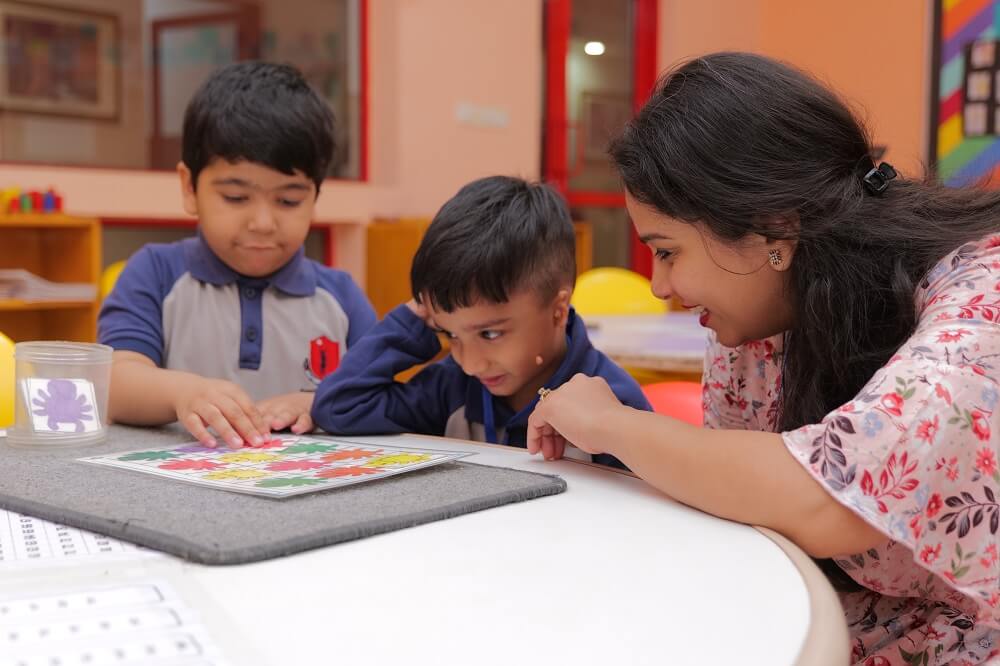Classroom scene 1 (a twin decade back): Teacher tutoring from the dais at the front of the room. Students sitting in rows and learning. Some hurriedly penning down notes in notebooks while some immersed in textbooks open in front of them.
Classroom scene 2 (today): Teachers with Bluetooth enabled, wireless, 2.4GHz USB handheld laser pointer, pointing towards PPT screen at the front of the room. Students sitting with their laptops/tablets configured with the main screen and experiencing a whole new dimension of learning.
Abridging the scenarios mentioned above, it isn’t difficult to deduce that technology has led to a paradigm shift in the field of education. And we, at Excelsior American School, one of the top schools in Gurgaon, believe that this rabid revolution definitely earns a mention of its own in the history of educational technology. The said facet has come a long way, starting from using:
- The low-cost printing press in the 1640s
- Slate boards and chalkboards in the 18th century
- Reliable postal service in the 1840s leading to the first formal correspondence education with an open university
- The advent of overhead projectors around the year 1945,
- Video-conferencing enabling streaming of lectures in the 1980s
- The electronic projectors and presentational software such as PowerPoint in around 1990
- Formal launching of world wide web in the year 1991
- Web-based learning management system in the mid-1990s
- Google, emerging as the primary search engine in the year 1999
- The early 2000s leading to the introduction of webinars over the internet
- YouTube, in the year 2005, getting increasingly used for short educational clips or online courses
- Then came The Khan Academy in the year 2006, which used voice-overs and digital blackboards
- And finally, the social media upsurge, casing a wide variety of diverse technologies such as blogs, vlogs, wikis, Twitter, Skype, FB, etc.
One thing that’s pretty evident is that technology has left a profound impact on modern-day education. It has gifted certain such virtues to the teachers as well as the student fraternity that are truly valuable as well as irreplaceable.
For educators, technology has become a central component for mapping the curriculum, instructing in the classrooms, and assessing the knowledge acquisition by the students. Similarly, for students too, it has brought along:
- The enormous expansion in access to education
We all are aware that manuscripts and textbooks were a rare commodity in older times, and only the privileged few had access to education. Wisdom seekers used to go and sometimes even travel to the hubs or places of learning to gather knowledge. However, today, a huge quantity of information (in the form of books, images, audios, videos) is obtainable with just a touch of a finger via the internet.
Also, opportunities for recognized courses are being offered online globally via platforms like traditional online degree programs, The Khan Academy, podcasts, and much more. Thus, access to education today is unparalleled in scope, for which full credit goes to technology.
- Prospects for communication and teamwork
Conventionally, the classrooms have remained more or less cut off, and teamwork has been restricted to just other classmates in the same classroom. However, today, technology has enabled such forms of communication and teamwork that were termed as next to impossible in the past.
For instance, today, a student miles away in a remote rural area can learn about a scientist’s expedition, read his blog postings, view the photos uploaded by him, e-mail questions or queries to him, and lastly, can even chat live with him via a video-conferencing call.
Today, students can share their learnings with not just students in other classrooms but also the ones in other states following and tracking the same event. Also, they can team up on group projects with the help of technology-based apparatuses like wikis and Google docs. Thus, today, it could be said that the four walls of a classroom are not an obstacle anymore, for technology has opened up novel means of gaining knowledge, communicating, and teamwork.
- Modifications in the functions of teachers as well as learners
In the traditional classroom setting, the teacher has always been the primary source of information, and learners have received it inertly. This model of teacher as a ‘sage on the stage’ has existed in our education system for a long time. However, because of the road of info and learning prospects that technology has opened, today, in a lot of classrooms, we see a teacher’s image taking the form of a ‘guide on the side.’ It is happening because the student of today has more conscientiousness for his learning by taking assistance of technology in order to gather info.
- Opens up new career domains
Last but not least, today, one can even make use of technology to shape up one’s career by pursuing masters and degrees in this very field, e.g., Masters of Science and Education in Design and Technology, and more alike. Such curriculums and courses offer opportunities to study as well as partake in the exciting latest technologies that are determining the future of the education arena.
In a nutshell, it is pretty evident that technology has seeped right into the framework of the education world and is working to improve and strengthen it. Technology has not only helped to expand the knowledge horizons for the learners but has also turned out to be a powerful aid for the educators. No wonder leading educational institutions across the world, including us, at the Excelsior American School, one of the top schools in Gurgaon, have openly embraced the booming technology to revamp the learning methodologies and come up with a novel model of education wherein everyone involved in the learning process is equally benefitted.


